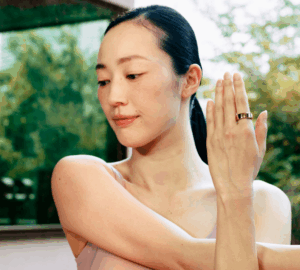- Non sleep deep rest (NSDR) is a term coined by neuroscientist Andrew Huberman, PhD, though it includes ancient practices like yoga nidra and protocols like self-guided hypnosis.
- Practicing NSDR can lead you into a deep state of relaxation through mindfulness tools like visualization and body scans.
- Oura members can track their biometrics such as HRV and body temperature trends during an NSDR or yoga nidra practice with an Unguided Session.
How often do you take time to fully relax during the day? And we don’t mean sitting on the couch, scrolling social media, or even getting a massage — we mean real, restorative, deep rest.
If that’s not a frequent part of your day, you’re certainly not alone. But you might want to learn more about non-sleep deep rest, or NSDR, how to practice it, and the science-backed benefits of it.
What Is Non-Sleep Deep Rest (NSDR)?
While resting might sound easy in theory, true deep rest is actually one of the most challenging practices. “Often when we think we’re resting, it’s not deep rest,” says Elissa Epel, PhD, an Oura medical advisor and stress expert who recently published a study on deep rest states. “Deep rest is better than our usual relaxation — it’s biologically restorative,” Epel writes in her book, The Stress Prescription.
 This is where NSDR comes in. NSDR is a practice in which you lie down, breathe, and enter a state of “deep rest.” Research-backed benefits may include greater recovery, lower stress, higher energy levels, and a clearer mind (more on the benefits below).
This is where NSDR comes in. NSDR is a practice in which you lie down, breathe, and enter a state of “deep rest.” Research-backed benefits may include greater recovery, lower stress, higher energy levels, and a clearer mind (more on the benefits below).
NSDR came into the wellness world’s lexicon in 2022, when neuroscientist and Stanford professor Andrew Huberman, PhD, coined the term to encompass the ancient practice of yoga nidra and related protocols, like self-guided hypnosis.
“NSDR encompasses a lot of practices that are not ‘meditation,’ per se, but practices that bring the brain and body into a state of relaxation and focus,” Huberman explains in an interview. “Unlike meditation, which requires focus, the goal of NSDR is to put you in a relaxed state that you don’t have to work hard to be in.”
This is the state of consciousness between wakefulness and sleep, known as a “hypnagogic state.”
What are the Origins of NSDR/Yoga Nidra?
While NSDR may be a recent term, the practice has existed for centuries, known as yoga nidra.
Yoga nidra is an ancient practice from India. During Shavasana, the final pose performed in a yoga flow, the practitioner often enters yoga nidra, or “yogic sleep.” Yoga nidra can be considered a spiritual meditation that aligns practitioners “with the most spiritual part of their inner nature.”
For this reason, it differs from Huberman’s NSDR protocol, which removes the spiritual aspect with the intention of making it more widely accessible.
In an episode of the Huberman Lab podcast, Huberman explains that he wanted to change the terminology because of “what some people might perceive as related to the yoga community, or specific to new age-y type techniques.” He states that “complicated language can be a separator and can discourage people from taking on these protocols, which are extremely useful.”
It should also be noted that all of the robust evidence used by Huberman to promote NSDR are studies that have analyzed yoga nidra.
| Member Tip: Track your NSDR practice on the Oura App by starting an Unguided Session. When you complete the session, you’ll get immediate biofeedback, showing how your biometrics like heart rate and heart rate variability responded to the practice. |
What Does an NSDR Practice Involve?
During a typical NSDR practice, you will lie down in a comfortable position as an instructor or guide leads you through steps intended to release tension and promote relaxation.
While it depends on your particular instructor, a practice may involve:
- Intention Setting: In yoga nidra, this is referred to as a “sankalpa.” Setting a positive intention at the start of your practice can help to anchor it in your subconscious mind.
- Body Scan: You may be guided systematically through your body to focus your attention on certain areas of the body. You may become aware of certain sensations to ultimately release tension and fall further into a state of relaxation.
- Deep breathing: “Constant states of high-stress arousal mean shallow breathing and chronic wear and tear on our cells,” says Epel. Deep breathing activates your parasympathetic nervous system, helping you to get out of fight-or-flight mode.
- Visualization: Your NSDR guide may encourage you to visualize a peaceful scene, like a garden or a beach. The goal is to get out of your conscious mind and into the subconscious. While this may sound new age-y, it’s rooted in research.
Ready to try? Here’s a 10-minute guided video from Huberman. YouTube has plenty of other NSDR variations as well.
Who Should Practice NSDR?
Anyone can practice NSDR! You may especially want to consider it if you’re looking to boost your energy, balance out stress with restorative time, or fall asleep faster.
For pregnant individuals in their second trimester and beyond, you should consider adjusting your position to avoid laying flat on your back.
Before starting any new wellness protocol, speaking with a medical professional is advisable.
When Should You Practice NSDR?
When you practice NSDR will depend on what you’re trying to target. For instance, if you want to unwind for the day to fall asleep easier, you can practice yoga nidra for sleep. To combat daytime stress, practice NSDR during the day.
How Long Should a Session Last?
Huberman advises 10 to 30 minutes daily of NSDR to get the benefits. However, a traditional yoga nidra session can take between 30 minutes to one hour.
Note that you may feel like you’re falling asleep, and you might actually fall asleep — which may be your intended outcome! Even if you didn’t mean to fall asleep, according to Huberman, that’s fine — you’ll still get the benefits associated with the practice.
What Happens During NSDR?
“When deep rest happens, something unique occurs in the brain,” Epel explains. “It is the opposite of being in a vigilant state.” Your sensory perceptions are enhanced, your body is relaxed, and your brain state is marked by high levels of theta and delta brainwaves. Some of the results may include:
- Accessing of brainwave states: Theta brain waves are associated with the subconscious mind, such as daydreaming, memories, and creativity. Delta brainwaves are linked to deep relaxation, which is why they predominantly occur during the deepest stages of sleep. Additionally, “there’s a pulsing of cerebrospinal fluid, which cleans out amyloid proteins and other debris from our brain,” says Epel.
- Cellular rejuvenation: In Epel’s own research on deep rest, she found that deep rest mimics the cellular rejuvenation that happens during the deepest stage of sleep. In other words: Your brain experiences the restorative and refreshing benefits of deep sleep — while awake.
- Stress regulation: “Your levels of psychological and physiological stress arousal are at their lowest. This signals to your brain that you’re safe, and it helps you break out of the pattern of constant stress arousal,” says Epel. A study examining the brain during yoga nidra found that the occipital lobe (the brain’s visual center) and the parietal lobe (sensory perception) are active. This activation can lead to emotional regulation, as well as feelings of relaxation and ease.
READ MORE: The Benefits of Sleep for Brain Health
What are the Benefits of Non-Sleep Deep Rest?

1. It can lower stress.
“Our default state isn’t usually relaxing enough,” Epel says. “You want to go below our habitual stress baseline, to true rest. This is what brings physiological restoration to the mind and body that we desperately need, to overcome stress.”
Studies show that NSDR can reduce stress and anxiety, promote emotional regulation and self-awareness, and build resilience to stress.
A 2019 study found that when university students practiced yoga nidra for one hour bi-weekly for eight weeks, their stress intensity decreased significantly, and their self-esteem increased significantly.
| Member Tip: As you tag NSDR or yoga nidra on Oura, over time, you may start to see how this impacts your Daytime Stress level and Resilience level. |
LEARN MORE: Resilience: Improve Your Ability to Recover From Stress
2. It can help you sleep better.
It’s hard to sleep when your mind is active. NSDR before bed is a great way to unwind. A 2022 study found that after two weeks of yoga nidra, participants increased their total duration of sleep, sleep efficiency, and quality.
READ MORE: How Stress Affects Your Sleep

3. It’s more restorative than most “relaxing” activities!
“You may think that lounging on the couch watching your favorite show, or taking your dog for a walk are relaxing activities,” says Epel. “But a common mistake is confusing breaks and leisure with true restoration.” Yoga nidra and deep rest are a “total break from busy mind activity, allowing for true relaxation,” she explains.
4. It can promote neuroplasticity.
Neuroplasticity is your brain’s ability to change in response to new experiences or stimuli – it helps your brain stay young, agile, and resilient.
Studies show the visualization component of NSDR stimulates brain regions associated with learning, memory, and emotional regulation. When you regularly practice NSDR, you strengthen neural connections and neuroplastic changes.
READ MORE: How to Build Resilience to Stress with a Growth Mindset
5. It can increase focus and creativity.
Taking a rest may seem counterproductive to creativity, but it’ll give you the boost you need. According to Huberman, NSDR has “neurochemical replenishing effects,” referring to the power of NSDR to increase dopamine levels and cerebral blood flow. When you reduce stress, sleep better, and stimulate the brain, your focus and creativity can skyrocket.
RELATED: Try Oura’s Guided Sleep Meditations for Deep and Restful Sleep




